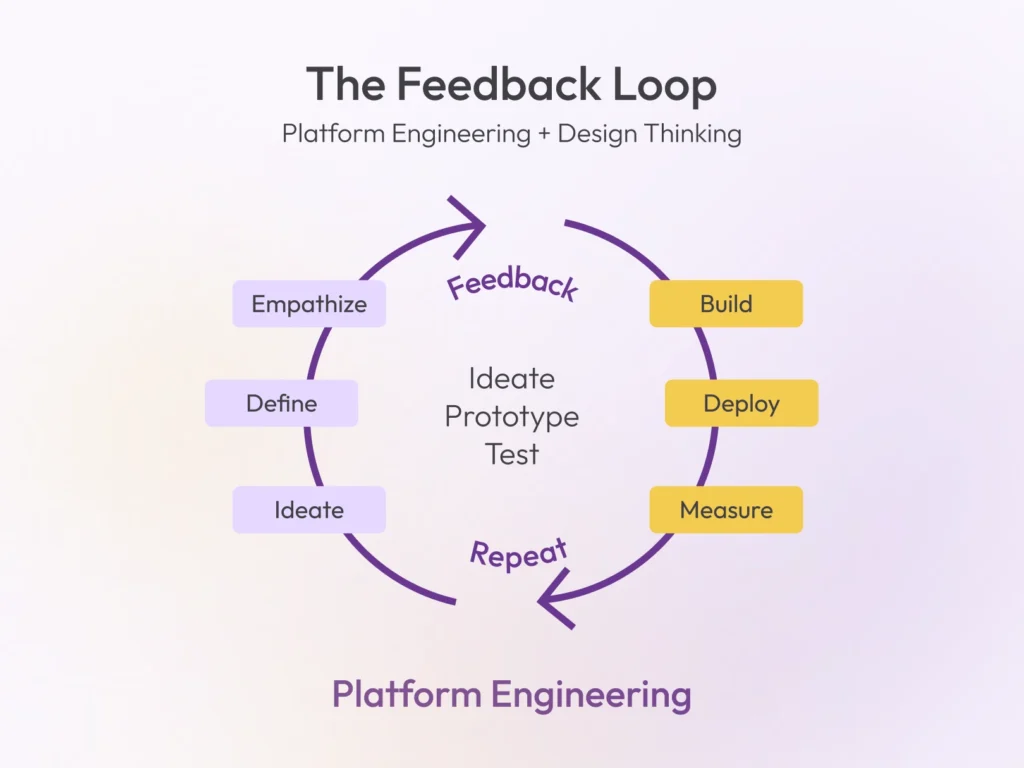Um tolle Produkte zu entwickeln, braucht es mehr als nur das Schreiben von Code. Produktentwicklung ist der ganze Prozess vom Entwerfen, Entwickeln, Testen und Liefern von Produkten, die den Bedürfnissen der Nutzer und den Geschäftszielen entsprechen. Dabei werden Technik, Design und Strategie kombiniert, um skalierbare, hochwertige Lösungen zu liefern.
Aber Produktentwicklung passiert nicht einfach so. Plattformentwicklung sorgt für die internen Tools, Abläufe und Automatisierung, die es den Produktteams ermöglichen, schneller zu arbeiten, manuellen Aufwand zu reduzieren und selbstbewusst innovativ zu sein.
Plattform-Engineering ist der unsichtbare Motor hinter jedem erfolgreichen Produkt.
Warum Plattform-Engineering heute wichtig ist
Traditionelles DevOps hängt oft von manuellen Einstellungen, fragmentierten Tools und teamübergreifender Koordination ab, was zu Ineffizienzen und Verzögerungen führt. Platform Engineering löst diese Probleme durch automatisierte Self-Service-Umgebungen, die operative Engpässe beseitigen und Entwicklungsprozesse standardisieren.
Die wichtigsten Vorteile von Plattform-Engineering sind:
- Entwickler-Produktivität und Zusammenarbeit
- Self-service portals reduce context switching and give teams the autonomy to deploy and test without waiting on operations.
- Reusable components (like Infrastructure as Code modules, CI/CD templates, or shared libraries) prevent “reinventing the wheel,” so developers can focus on building features.
- Shared platforms standardize tools and workflows, streamlining communication and handoffs across teams.
- Reliability and Security by Design
- Eine einheitliche Infrastruktur hilft dabei, menschliche Fehler und Konfigurationsabweichungen zu vermeiden.
- Automatisierte Tests und CI/CD-Pipelines, wie z. B. GitHub Actions oder GitLab CI können Fehler und Schwachstellen frühzeitig erkannt werden.
- Wenn du eine wiederverwendbare Komponente aktualisierst, wird automatisch die Sicherheit und Qualität aller damit verbundenen Projekte verbessert.
- Kosten-Effizienz und Nachhaltigkeit
- Automatisierung und wiederverwendbare Ressourcen sparen Betriebskosten und machen Flickwerk-Lösungen überflüssig.
- Konsistenz über alle Systeme hinweg reduziert technische Schulden und macht es einfacher, Plattformen zu warten und weiterzuentwickeln.
- Skalierbarkeit und Zukunftsfähigkeit
- Interne Entwicklerplattformen (IDPs) lassen sich einfach skalieren, um den steigenden Bedarf an Infrastruktur und Anwendungen zu decken.
- Neue Tools und Frameworks lassen sich dank standardisierter Vorlagen und Automatisierung schnell einbinden.
- Zentrale Entwicklerportale (Backstage oder Humanitec) machen alle Komponenten auffindbar und sorgen für Governance, damit Best Practices standardmäßig eingehalten werden.
Dank Plattform-Engineering können sich Produktteams voll auf Funktionen, Experimente und den Nutzen für die Nutzer konzentrieren, was direkt zu besseren Produkten führt.
Wie Plattform-Engineering die Produktentwicklung unterstützt
Produktentwicklung konzentriert sich darauf, Endnutzern einen Mehrwert zu bieten, und die Plattformentwicklung sorgt dafür, dass die Teams die richtige Grundlage haben, um dies effizient zu tun.
Interne Entwicklerplattformen (IDPs), die von Plattformingenieuren entwickelt werden, bieten:
- Automatisierte Bereitstellung und Tests (CI/CD): CI/CD-Pipelines checken und liefern Code zuverlässig, was häufigere Releases und schnellere Innovationen ermöglicht.
- Sichere Self-Service-Umgebungen: Entwickler können Ressourcen bereitstellen und Anwendungen ohne manuelle Genehmigungen einrichten und dabei ganz einfach die Compliance sicherstellen.
- Weniger Abhängigkeiten zwischen Teams: Standardisierte Arbeitsabläufe sorgen dafür, dass es seltener zu Verzögerungen zwischen Teams kommt, verbessern die Übergaben und beschleunigen die Produktlieferung.
Durch die Beseitigung von Reibungsverlusten und die Bereitstellung einer konsistenten, zuverlässigen Infrastruktur sorgt die Plattformtechnik dafür, dass Teams mehr Zeit mit der Entwicklung wertvoller Funktionen verbringen und weniger Zeit mit der Verwaltung von Umgebungen.
Design denken und Plattformentwicklung verbinden
Während sich die Plattformentwicklung darauf konzentriert, die Backend-Infrastruktur in Sachen Geschwindigkeit, Skalierbarkeit und Zuverlässigkeit zu optimieren, sorgt das Produktdesign, das sich am Design Thinking orientiert, dafür, dass das Produkt die richtigen Probleme für die Nutzer löst.
Design Thinking ist ein iterativer, nutzerzentrierter Prozess, bei dem Empathie, Ideenfindung, Prototyping und Testen im Vordergrund stehen. In Kombination mit Platform Engineering können Produktteams damit:
- Schnelle Erstellung von Prototypen für Benutzerabläufe und Funktionen mithilfe standardisierter, reibungsloser Umgebungen
- Ideen schnell durch wiederholte Tests mit echten Nutzern überprüfen
- Technische Machbarkeit mit den Wünschen der Nutzer und den Geschäftszielen abstimmen
Bei AnchorzUp teilen sich die Plattform-Engineering- und Designteams den Zugriff auf gemeinsame Umgebungen, wiederverwendbare Komponenten und Designsysteme. Dieser einheitliche Ansatz macht die Übergabe vom Design zur Entwicklung einfacher und bringt Innovationen schneller voran.
Design denken und Plattformentwicklung verbinden
Während sich die Plattformentwicklung darauf konzentriert, die Backend-Infrastruktur in Sachen Geschwindigkeit, Skalierbarkeit und Zuverlässigkeit zu optimieren, sorgt das Produktdesign, das sich am Design Thinking orientiert, dafür, dass das Produkt die richtigen Probleme für die Nutzer löst.
Design Thinking ist ein iterativer, nutzerzentrierter Prozess, bei dem Empathie, Ideenfindung, Prototyping und Testen im Vordergrund stehen. In Kombination mit Platform Engineering können Produktteams damit:
- Schnelle Erstellung von Prototypen für Benutzerabläufe und Funktionen mithilfe standardisierter, reibungsloser Umgebungen
- Ideen schnell durch wiederholte Tests mit echten Nutzern überprüfen
- Technische Machbarkeit mit den Wünschen der Nutzer und den Geschäftszielen abstimmen
Bei AnchorzUp teilen sich die Plattform-Engineering- und Designteams den Zugriff auf gemeinsame Umgebungen, wiederverwendbare Komponenten und Designsysteme. Dieser einheitliche Ansatz macht die Übergabe vom Design zur Entwicklung einfacher und bringt Innovationen schneller voran.

Praktische Anwendung
Führende Unternehmen wie Spotify, Airbnb und Netflix setzen auf Produktentwicklungsprinzipien, um:
- Netflix macht jeden Tag Tausende von Deployments mit minimalen Ausfallzeiten möglich, was schnelle Experimente und Innovationen erlaubt. Über die Bereitstellung hinaus investiert Netflix in Tools zur Steigerung der Entwicklerproduktivität, wie interne Designsysteme, Dashboards, Datenanalyseplattformen und Open-Source-Projekte wie Simian Army und Spinnaker. Diese Tools optimieren die interne Entwicklung und beeinflussen die Best Practices der Branche.
- Spotify hat Backstage entwickelt und als Open Source veröffentlicht. Das ist ein internes Entwicklerportal, das als „zentrales Nervensystem“ für die Infrastruktur von Spotify dient. Diese Plattform hilft Tausenden von Ingenieuren dabei, täglich Zehntausende von Softwarekomponenten zu verwalten.
- Airbnb hat seine Bemühungen um die Entwicklerplattform und die Produktivität der Entwickler strukturiert und weiterentwickelt, um die Entwicklererfahrung und -with-a-dose-of-ai-disruption" target="_blank" rel="noreferrer noopener">Entwicklerplattform und die Produktivität im Bereich Engineering weiterentwickelt, um die Entwicklererfahrung und die interne Effizienz zu verbessern.
Plattform-Engineering: Der neue Standard für skalierbare Produktentwicklung
Plattform-Engineering verändert total, wie digitale Produkte entwickelt werden. Durch die Automatisierung der Infrastruktur, die Optimierung der Zusammenarbeit und die Integration von Design- und Entwicklungsabläufen können Produktteams bessere Software schneller liefern.
Da digitale Produkte immer komplexer werden, können Unternehmen, die jetzt in Plattform-Engineering investieren, bessere, schnellere und sicherere Produkte entwickeln und dabei mit glücklicheren und produktiveren Teams arbeiten.
Bist du bereit, deine Produktentwicklung zukunftssicher zu machen? Schreib uns, um zu erfahren, wie Plattform-Engineering deinen Erfolg beschleunigen kann.
